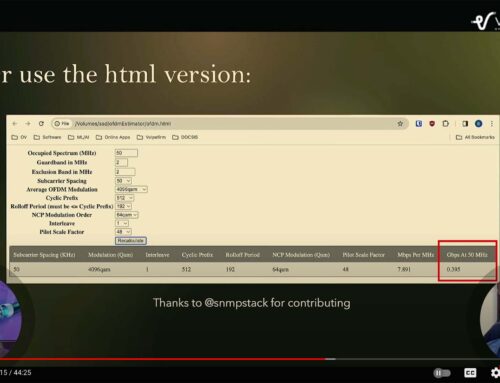What’s Next for DOCSIS Modulation Options and Impacts
This paper is the second in a series titled “What’s Next for DOCSIS:” (Young, 2012), and outlines the anticipated DOCSIS near, medium, and long term next generation (NG) network specifications; identifies and presents high spectral efficiency (SE) modulation options capable of enabling DOCSIS 3.1/NG network specification compliance; identifies the likely modulation technique winner(s) and why; and finally presents NG network operational, test, and troubleshooting challenges facing network installers and repair technicians.
SECTION 2
INTRODUCTION – What is Modulation Anyway?
Modulation is the process of transmitting data, such as digital data or an analog signal. This is done particularly in the cable television (CATV) industry such that the baseband data can be converted to RF frequencies and transmitted on the hybrid-fiber coaxial (HFC) plant. One of the three key characteristics of a signal is usually modulated are its phase, frequency or amplitude. A device that performs modulation is known as a modulator and a device that performs demodulation is known as a demodulator. A device that can do both operations is a modem (a contraction of the two terms).
Examples of each modulation type will be given as follows:

Amplitude Modulation (AM)
Amplitude modulation (AM) is a form of modulation in which the amplitude of a carrier wave is varied by modulating it with baseband signal (see figure 1 above). AM is commonly used at radio frequencies (RF) and was the first method used to broadcast commercial radio. The term “AM” is sometimes used generically to refer to the AM broadcast (medium wave) band. The output of this process is a signal with the same frequency as the carrier but with peaks and troughs that vary in proportion to the strength of the modulating signal. AM signals are usually amplified and then applied to the input of large antennas for wireless broadcasts.

Frequency Modulation
Frequency modulation (FM) is a form of modulation, which represents analog or digital data as variations in the frequency of a carrier wave (see figure 2 above).
In analog applications, the carrier frequency increases as the amplitude of the baseband signal increases; similarly the frequency decreases as the amplitude of the baseband signal decreases. Shifting the carrier frequency between a set of high and low frequency values can represent digital data.
FM is commonly used at VHF RF broadcasts of music and speech, which is well known as FM stereo. Analog TV sound also uses FM for transmission of the audio in CATV and over-the-air broadcasts.

<
div title=”Page 7″>
Phase modulation (PM) is a form of modulation, which represents information as changes in the phase of a carrier wave (see figure 3 above). The changes of phase represent increasing or decreasing amplitudes of the baseband signal. Similarly, fixed blocks of phase shifts representing ones’ and zeros’ can represent digital data.
By itself, PM is not very widely used. This is because it tends to require more complex receiving hardware and/or software algorithms and there can be problems with determining whether, for example, the signal has 0° phase or 180° phase.
Complex Modulations
Typically low order modulations, such as AM, FM and PM that were just discussed, are not effective for carrying lots of data. However when more than one type of modulation are combined together more data can be transmitted over the same frequency. More data in the same bandwidth is the objective of many communication systems and DOCSIS is no exception. Therefore, when AM and PM modulation are combined along with some additional math, Quadrature Amplitude Modulation (QAM) is achieved. This is the fundamental building block of digital video and data communications in modern CATV networks.
Complex modulations transporting digital data are simply more analog signals as the ones examined so far. However they are more complex. For example, examine the next figure which represents the analog signals of a 16-QAM signal transporting digital data. Again it is important to remember that QAM is still analog:

16-QAM Signals
Generally QAM signals are not displayed in their analog waveform views as above. Industry test equipment takes the analog signal, samples it at discrete times and displays a constellation diagram as shown below:

16-QAM Constellation Diagram
Many in the CATV industry are familiar with constellation diagrams and also understand how to analyze them for impairments in the QAM signal. What should be taken away from this is that QAM is still analog signals that transmit digital data. The analog signals themselves do not differ greatly from AM, FM or PM modulation other than the fact that they are a little more complex. The tools that are used in the industry to present the content of the data contained in QAM modulation sometimes allow us to forget that QAM signals are analog signals.
SECTION 3
What is DOCSIS 3.1 and Why Do We Need It?
DOCSIS 3.1 is the fourth (4th) generation DOCSIS (Data Over Cable Service Interface Specifications) standard currently under development by CableLabs. The standard has a number of objectives, the most significant of which is to enable downstream bandwidth capabilities of 10 Gigabit per second speeds and upstream speeds of one Gigabit per second. Many may question why are these speeds required? To answer this question the history of DOCSIS speed growth will first be examined.
Legacy DOCSIS Speed Comparison
The DOCSIS standards began with DOCSIS 1.0 and then DOCSIS 1.1, which are often referred to as DOCSIS 1.x since only minor changes were made between the two standards primarily impacting quality of service (QoS) and not speed. Next came DOCSIS 2.0, which had significant speed improvements, not mentioning impairment deterrent features, in addition to numerous other features that made DOCSIS competitive against telecom operators such as Verizon and AT&T. Finally, DOCSIS 3.0 arrived, the current standard in production that provided four to eight or more times the speed of DOCSIS 2.0. At the time this provided industry-shattering speeds thought to last for a decade or more. Follows is a chart comparing the speeds between DOCSIS 1.x, 2.0 and 3.0.

DOCSIS Version Throughput Comparison
From the figure it is evident that the downstream net throughput speed increased nearly 10x, from 38 Mbps to over 300 Mbps. Similarly, the same 10x increase occurred in the upstream from 9 Mbps to over 100 Mbps. The increase occurred between the years 1997 to 2006, roughly 10 years, which is the time between the release of the DOCSIS 1.0 standard and the DOCSIS 3.0 standard.
By simply applying this logic to standards moving forward, one could assume that in 10 more years a standard would be required needing 3 Gbps in the downstream and 1 Gbps in the upstream using the 10x multiplier. However history and experience provides additional information that can be used to show the 10x multiplier is not the wisest choice to follow. First, companies such as Cisco have performed extensive studies indicating that DOCSIS traffic is growing in the downstream by 50% each year and 30% on the upstream. Further, competition is providing data services far in excess of the 10x multiplier using passive optical network (PON) technologies. Therefore the DOCSIS working group has the objective to provide a standard to support 10 Gbps in the downstream and 1 Gbps in the upstream with room for growth.
Understanding Bits Per Hertz (Spectral Efficiency)
How will these goals be achieved? By using higher order modulations and thus packing more bits per Hertz. Before higher order modulations are discussed, bits per Hertz will covered. Bits per Hertz is a term used in the industry to describe how efficient (spectral efficiency) a given modulation is at transmitting data in a given bandwidth. It is generally expressed as bits/s/Hz, which is the proper mathematical expression, however many people will verbally refer to it as bits per Hertz, so it is important to understand both the notation and verbal expression. Calculating the spectral efficiency of any modulation and presenting it in bits/s/Hz is simple. Just divide its data rate in bps by the bandwidth it occupies. Here is an example:
<
div title=”Page 11″>
From the DOCSIS throughput figure, DOCSIS 2.0 has a maximum downstream net throughput of 38 Mbps in 256-QAM. We know that a DOCSIS channel occupies 6 MHz of bandwidth. Therefore the spectral efficiency of a DOCSIS 256-QAM channel is:
38 Mbps / 6 MHz = 6.33 bits/s/Hz
Comparing Spectral Efficiency
Now that a reference point has been made for 256-QAM, it can be compared to other modulations. For example, the spectral efficiency of 16-QAM in a 3.2 MHz bandwidth (common in the upstream for cable modems) is 2.5 bits/s/Hz. It is clear that 256-QAM is 2.5 times more efficient than 16-QAM.
One way to get more data in the downstream would be to increase the modulation. What would be the spectral efficiency of 4096-QAM? Calculating the throughput is fairly simple if you have a scientific calculator. The formula is as follows:
throughput = log2(modulation) * rate,
where modulation = 4096 and rate is the symbol rate, which will be left the same as in 256-QAM
of 5.360537 MSym/sec. This rate is based on the ITU-T J.83 Annex B specification. throughput = log2(4096) * 5.360537 MSym/sec = 64.33 Mbps
Due to DOCSIS overhead the net throughput will drop to about 54 Mbps. Now the spectral efficiency in a 6 MHz bandwidth can be calculated as:
54 Mbps / 6 MHz = 9 bits/s/Hz
By using 4096-QAM an increase of 40% in data rate can be achieved in the same bandwidth.
This is a driving force behind the DOCSIS 3.1 standard.
By Brady Volpe and Conrad L. Young
CED October 2013 – You can also view this article on CED October 2013
Previous events can be seen under the blog.
- If you are watching this on youtube please hit the subscribe button!
- Let us know what you think and remember to share!
- You can find slides at the bottom of the page and some on slideshare.
- Find out about events or articles by following us on Twitter, LinkedIn or Facebook too.
- We have stuff. Interested in buying some clothes with cable stuff. Click here
Also available on iTunes, Google Podcasts, Spotify, vurbl see podcasts “get your tech on”.





Leave a Reply